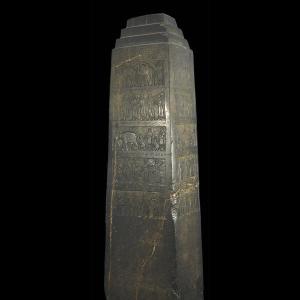By Jason Dulle
 1 Kings 19:15-16 The Lord said to him, “Go back the way you came and then head for theDesert of Damascus. Go and anoint Hazael king overSyria. 19:16 You must anoint Jehu son of Nimshi king overIsrael, and Elisha son of Shaphat from Abel Meholah to take your place as prophet.
1 Kings 19:15-16 The Lord said to him, “Go back the way you came and then head for theDesert of Damascus. Go and anoint Hazael king overSyria. 19:16 You must anoint Jehu son of Nimshi king overIsrael, and Elisha son of Shaphat from Abel Meholah to take your place as prophet. 2 Kings 10:36 Jehu reigned over Israel for twenty-eight years inSamaria.
In 1846 archaeologists discovered a black basalt, four-sided obelisk measuring 6’5” in Kalhu, Iraq (modern Nimrud). This was the site of the ancient Assyrian capital. The obelisk was erected as a public monument in 825 BC, glorifying Shalmaneser III’s (858-824 BC) military exploits over a period of 31 years. It contains a mixture of reliefs and inscriptions recording the conquests of Assyrian King Shalmaneser III. There are a total of 20 reliefs: five per side. Five different kings are pictured paying tribute to Shalmaneser: (1) Sua of Gilzanu; (2) ruler of Musri; (3) Marduk-apil-usur of Suhi; (4) Qalparunda of Patin. The fifth king is none other than King Jehu of Israel, who payed tribute to Shalmaneser in ~841 BC, approximately 10 years before Jehu’s reign ended. The inscription connected to the relief of Jehu reads, “The tribute of Jehu, son of Omri: I received from him silver, gold, a golden bowl, a golden vase with pointed bottom, golden tumblers, golden buckets, tin, a staff for a king [and] spears.” 

This event is not recorded in the Bible. Indeed, the Bible does not record any of Jehu’s foreign affairs except for a brief comment that the Syrian king, Hazael, was taking away territory on the eastern border (2 Kings 10:32-33).
It might be asked why Jehu would pay tribute to an Assyrian king. We can’t be certain, but he probably did so because he was defeated by Shalmaneser, or because he was seeking protection from Hazael, king of Damascus(2 Kings 10:32). Shalmaneser would be amenable to helping Jehu (for a price, of course) since both he and Jehu shared a hatred for the former king of Israel, Ahab, who had joined in a coalition against Shalmaneser in 853 at the Battle of Qarqar (recorded in the Kurkh Monolith).
Significance:
- Confirms the existence of King Jehu.
- Confirms the existence of the Northern Kingdom of Israel.
- It is the only depiction of anyone mentioned in the Bible made by a contemporary (and the earliest depiction of an Israelite king).
It is absolutely amazing to be able to see a picture of an Israelite king inscribed on a stone by one of the most powerful kings of one of the most powerful empires! Perhaps the engraver was even there to witness Ahab’s arrival, and pictured him just as he remembered him.
No comments:
Post a Comment